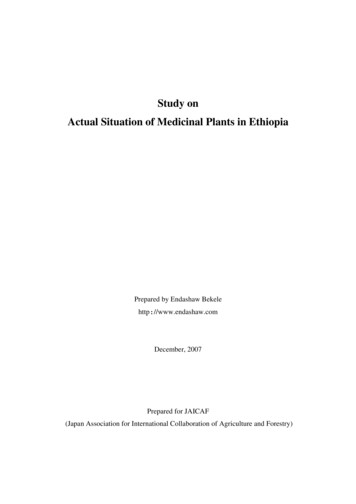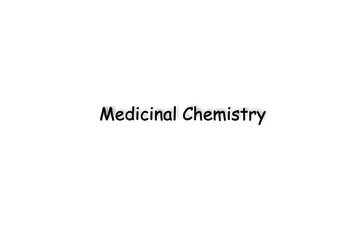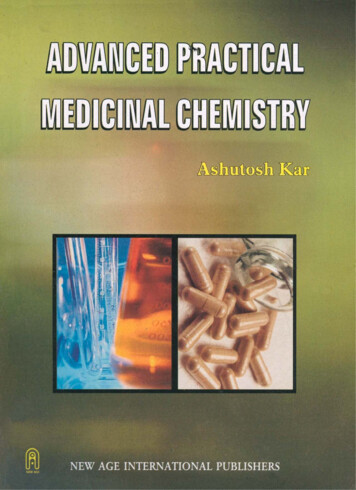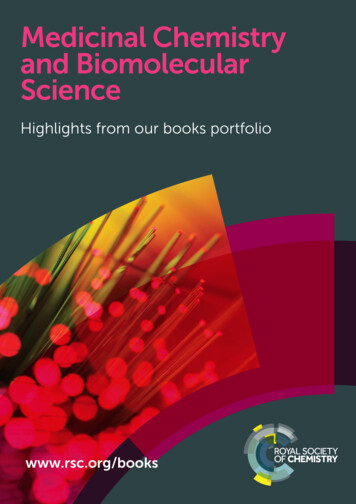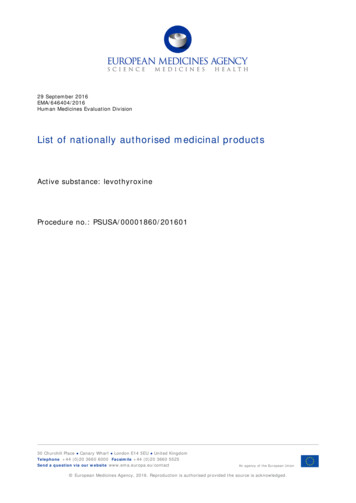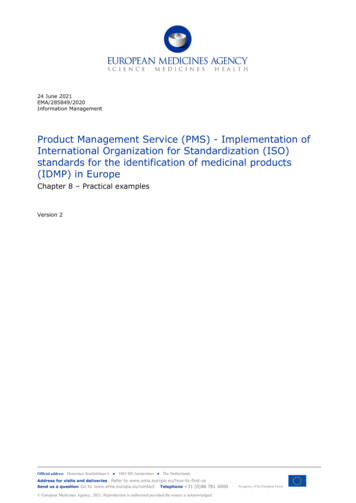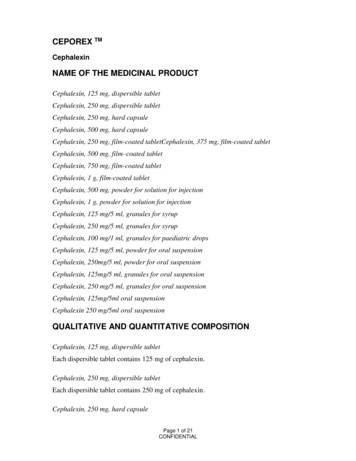
Transcription
CEPOREX TMCephalexinNAME OF THE MEDICINAL PRODUCTCephalexin, 125 mg, dispersible tabletCephalexin, 250 mg, dispersible tabletCephalexin, 250 mg, hard capsuleCephalexin, 500 mg, hard capsuleCephalexin, 250 mg, film-coated tabletCephalexin, 375 mg, film-coated tabletCephalexin, 500 mg, film–coated tabletCephalexin, 750 mg, film-coated tabletCephalexin, 1 g, film-coated tabletCephalexin, 500 mg, powder for solution for injectionCephalexin, 1 g, powder for solution for injectionCephalexin, 125 mg/5 ml, granules for syrupCephalexin, 250 mg/5 ml, granules for syrupCephalexin, 100 mg/1 ml, granules for paediatric dropsCephalexin, 125 mg/5 ml, powder for oral suspensionCephalexin, 250mg/5 ml, powder for oral suspensionCephalexin, 125mg/5 ml, granules for oral suspensionCephalexin, 250 mg/5 ml, granules for oral suspensionCephalexin, 125mg/5ml oral suspensionCephalexin 250 mg/5ml oral suspensionQUALITATIVE AND QUANTITATIVE COMPOSITIONCephalexin, 125 mg, dispersible tabletEach dispersible tablet contains 125 mg of cephalexin.Cephalexin, 250 mg, dispersible tabletEach dispersible tablet contains 250 mg of cephalexin.Cephalexin, 250 mg, hard capsulePage 1 of 21CONFIDENTIAL
Each hard capsule contains 250 mg of cephalexin.Cephalexin, 500 mg, hard capsuleEach hard capsule contains 500 mg of cephalexin.Cephalexin, 250 mg, film-coated tabletEach film–coated tablet contains 250 mg of cephalexin.Cephalexin, 375 mg, film-coated tabletEach film-coated tablet contains 375 mg of cephalexin.Cephalexin, 500 mg, film–coated tabletEach film–coated tablet contains 500 mg of cephalexin.Cephalexin, 750 mg, film-coated tabletEach film-coated tablet contains 750 mg of cephalexin.Cephalexin, 1 g, film–coated tabletEach film–coated tablet contains 1 g of cephalexin.Cephalexin, 500 mg, powder for solution for injectionEach vial contains 531.5 mg of cephalexin sodium equivalent to 500 mg of cephalexin.Cephalexin, 1 g, powder for solution for injectionEach vial contains 1.036 g of cephalexin sodium equivalent to 1 g of cephalexin.Cephalexin, 125 mg/5 ml, granules for syrupEach 5 ml of constituted syrup contains 125 mg of cephalexin.Cephalexin, 250 mg/5 ml, granules for syrupEach 5 ml of constituted syrup contains 250 mg of cephalexin.Cephalexin, 100 mg/1 ml, granules for paediatric dropsEach 1 ml of constituted drops contains 100 mg of cephalexin.Cephalexin, 125 mg/5 ml, powder for oral suspensionCephalexin, 125mg/5 ml, granules for oral suspensionPage 2 of 21CONFIDENTIAL
Cephalexin, 125mg/5ml oral suspensionEach 5 ml of constituted suspension contains 125 mg of cephalexin.Cephalexin, 250 mg/5 ml, granules for oral suspensionCephalexin 250 mg/5ml oral suspensionEach 5 ml of constituted suspension contains 250 mg of cephalexin.ExcipientsCephalexin, 125 mg, dispersible tabletMicrocrystalline cellulose (pH 102), Pregelatinised starch (Unigel 270), Crospovidone(Kollidon CL), Colour Sunset Yellow FCF, Sodium starch glycollate (Primogel),Monoammonium glycerrhizinate, Flavour trusil orange, Magnesium stearate , Talcpurified.Cephalexin, 250 mg, dispersible tabletMicrocrystalline cellulose, Pregelatinised starch, Crospovidone, Sodium starch Glycolate,Monoammonium glycerrhizinate, Magnesium stearate, Talc purified, Flavour trusilOrange special, Colour sunset yellow.Cephalexin, 250 mg, hard capsuleSupplier 1Magnesium stearate, empty hard gelation capsule shellSupplier 3Magnesium stearate ; Tartrazine, Brilliant Blue FCF, Titanium dioxide in epmptycapsule shellsSupplier 5Magnesium stearate, empty gelatin capsule No.2Supplier 6Magnesium stearateCephalexin, 500 mg, hard capsuleSupplier 1Page 3 of 21CONFIDENTIAL
Magnesium stearate, empty hard gelation capsule shellSupplier 3Magnesium stearate ;Erythrosine, Titanium dioxide , Sunset Yellow FCF, Ponceau 4R,Brillant Blue FCF in empty capsule shellsSupplier 5Magnesium stearate, empty gelatin capsule No.0Supplier 6Magnesium stearateCephalexin, 250 mg, film-coated tabletMagnesium stearate, Microcrystalline cellulose, Methylhydroxypropylcellulose, Titaniumdioxide, Erythrosine aluminium lake, Indigo carmine aluminium lake FD&C blue No.2Cephalexin, 375 mg, film-coated tabletMicrocrystalline cellulose (pH 101) IH, Hypromellose (K4MCR)BP, Hydroxypropylcellulose MIP, Hypromellose IH, Magnesium stearate IH, Purified talc IH, Colloidalanhydrous silica IH, Opadry OY-54956 Pink, Purified water IH, Opacode black S-117823, Isopropyl alcohol IH.Cephalexin, 500 mg, film-coated tabletSupplier 2Methylhydroxypropylcellulose, Titanium dioxide, Erythrosine aluminium lake, Indigocarmine aluminium lake FD&C blue No.2Supplier 4Magnesium stearate, Microcrystalline cellulose, Polyethylene glycol, OpadryCephalexin, 750 mg, film-coated tabletMicrocrystalline cellulose, Magnesium stearate, Opadry pink OY-S-6927 Macrogol 400Purified Water.Opadry pink OY-S-6927 contains: Hypromellose titanium dioxide (E171) Erythrosinealuminium lake, Indigo carmine aluminium lake FD&C Blue No. 2.Page 4 of 21CONFIDENTIAL
Cephalexin, 1 g, film-coated tabletMagnesium stearate, Microcrystalline cellulose, Methylhydroxypropylcellulose, Titaniumdioxide, Erythrosine aluminium lake, Indigo carmine aluminium lake FD&C blue No.2Cephalexin, 500 mg, powder for solution for injectionNot applicableCephalexin, 1 g, powder for solution for injectionNot applicableCephalexin, 125 mg/5 ml, granules for syrupSupplier 1Citric acid anhydrous, Sodium citrate anhydrous, Erythosine E 127, Pharmaceuticalpolvaromas No. 29, Sodium calcium edetate, Sucrose.Supplier 5Sodium citrate anhydrous, Citric acid anhydrous, Sodium calcium editate, FD & C SunsetYellow, Flavor imitation Orange Bramble, Sugar.Cephalexin, 250 mg/5 ml, granules for syrupSupplier 3Acacia powder, Calcium sodium edentate, Citric acid anhydrous, Colour Sunset Yellow,Flavour Trusil Orange, Sodium citrate, Sucrose, Isopropyl alcoholSupplier 5Sodium citrate anhydrous, Citric acid anhydrous, Sodium calcium editate, Acacia gumpowder, Sunset yellow, Flavor imitation orange bramble, Sugar.Cephalexin, 100 mg/1 ml, granules for paediatric dropsSupplier 3Sodium calcium edetate , Acacia powdered , Citric acid (Anhydrous) , Sodium Citrate(Anhydrous), Sucrose (Sugar Pharma Grade) Pulverised), Sucrose (Sugar Pharma Grade)Castor, Isopropyl alcohol , Flavour Orange Trusil, Colour Sunset Yellow FCFSupplier 5Page 5 of 21CONFIDENTIAL
Sodium citrate anhydrous, Citric acid anhydrous, Sodium calcium editate, Acaciapowder, Sunset Yellow, Flavor Imitation Orange Bramble, SucroseSupplier 6Sodium calcium edetate, Acacia, Orange Bramble Flavour SO 370, Polvaromas, CitricAcid BP anhydrous 100-Mesh, Sodium citrate anhydrous, Sunset Yellow Ariavit, CastersugarCephalexin, 125 mg/5 ml, powder for oral suspensionCephalexin, 250 mg/5 ml, powder for oral suspensionSodium calcium edetate, Acacia, Orange Bramble Flavour SO 370, Polvaromas, CitricAcid BP anhydrous 100-Mesh, Sodium citrate anhydrous, Sunset Yellow Ariavit, Castersugar, Icing sugarCephalexin, 125 mg/5ml, granules for oral suspensionSupplier 2Sodium calcium edetate, Acacia powder, Citric acid anhydrous, Sodium citrateanhydrous, Sunset yellow, Orange – bramble flavour polvaromas, Sucrose powder, WaterSupplier 4Sodium calcium edetate, Acacia, Citric acid (anhydrous), Sodium citrate (anhydrous),Eurocert Sunset Yellow 311831 (E110), Orange-bramble flavour polvaromas, Sucrose(Icing sugar, Caster sugar).Cephalexin, 250 mg/5 ml, granules for oral suspensionSupplier 2Sodium calcium edetate, Acacia powder, Citric acid anhydrous, Sodium citrateanhydrous, Sunset yellow, Orange – bramble flavour polvaromas, Sucrose powder,Water.Supplier 4Sodium calcium edetate, Acacia, citric acid (anhydrous), Sodium citrate (anhydrous),Eurocert Sunset Yellow 311831 (E110), Orange-bramble flavour polvaromas, Sucrose(Icing sugar, Caster sugar).Page 6 of 21CONFIDENTIAL
Cephalexin, 125mg/5ml oral suspensionCephalexin 250 mg/5ml oral suspensionPolysorbate 80, Xanthan gum, Micro crystalline cellulose, Aerosil 200, Aspartame,Disodium edetate, Sucrose, Lake of Quinoline Yellow, Banana flavour, Butylatedhydroxytoluene, Corn oilPHARMACEUTICAL FORMCephalexin, 125 mg, dispersible tabletPale pink to light orange coloured round, uncoated dispersible tablets with ‘125’engraved on one side and plain on the other side.Cephalexin, 250 mg, dispersible tabletPale pink to light orange coloured capsule shaped uncoated dispersible tablets with ‘250’engraved on one side and cursor line on the other side.Cephalexin, 250 mg, hard capsulesSupplier 1Hard gelatin capsules (size 2) with caramel coloured body and grey coloured locking cap,printed in white with ‘Ceporex 250mg and GSK’ on the capsule body / cap.Supplier 3Size ‘2’ locking type hard gelatin capsules with dark green cap and light green body,having "Phexin" printed in black on body and "GlaxoSmithKline" printed in white on thecap.Supplier 5Hard gelatin capsules with a caramel coloured body and a grey coloured cap printedCeporex 250 and GSK logoSupplier 6Size No. 2 hard gelatin capsule with a caramel coloured body and grey cap containingwhite to yellowish white powder. The capsule is printed with Ceporex 250 MG on thecap and GlaxoSmithKline on the body in the white ink.Page 7 of 21CONFIDENTIAL
Cephalexin, 500 mg, hard capsulesSupplier 1Hard gelatin capsules (size 0) with caramel coloured body and grey coloured locking cap,printed in white with ‘Ceporex 500mg & GSK’ on the capsule body / cap.Supplier 5Hard gelatin capsules with caramel coloured body and grey coloured cap printed‘Ceporex 500’ and ‘GSK’ logo.Supplier 3Size ‘0’ locking type capsules with black cap and rose pink body, having "Phexin" inblack on the body and "GlaxoSmithKline" in white on the cap.Supplier 6Size No. 0 hard gelatin capsule with an opaque caramel coloured body printed GS 3ZIaxially in white ink and a plain opaque dark grey cap containing white to yellowish whitepowder.Cephalexin, 250 mg, film-coated tabletConvex, pink film-coated tablets engraved “Cefalexin 250” on one side and “Glaxo” onthe other side.Cephalexin, 375 mg, film-coated tabletAs registered locally.Cephalexin, 500 mg, film-coated tabletSupplier 2Capsule shaped, pink film-coated tablets .Supplier 4Convex, pink film-coated round tablets, non-engraved.orFilm-coated tablet with capsule shape, orange colour, embossed in one side with GS CC5and plain on the other side.Cephalexin, 750 mg, film-coated tabletPage 8 of 21CONFIDENTIAL
As registered locally.Cephalexin, 1 g, film-coated tabletCapsule shaped, pink film-coated tablets .Cephalexin, 500 mg, powder for solution for injectionCephalexin, 1 g, powder for solution for injectionWhite to cream crystalline powder.Cephalexin, 125 mg/5 ml, granules for syrupSupplier 1Cream colour, fine granular powder with a characteristic odour.Supplier 5Pale orange granules with a characteristic odour.Cephalexin, 250 mg/5 ml, granules for syrupSupplier 3Pale pink to light orange free flowing granules with odour of orange.Supplier 5Pale orange granules with a characteristic odour.Cephalexin, 100 mg/1 ml, granules for paediatric dropsSupplier 3Pale pink to light orange free flowing granules with odour of orange.Supplier 5Pale pink granules with a characteristic odour.Supplier 6Pale pink to orange granules with a characteristic odour.Cephalexin, 125 mg/5 ml, powder for oral suspensionCephalexin, 250 mg/5 ml, powder for oral suspensionPale pink coarse powder with characteristic odour.Cephalexin, 125 mg/5 ml, granules for oral suspensionPage 9 of 21CONFIDENTIAL
Cephalexin, 250 mg/5 ml, granules for oral suspensionSupplier 2Supplier 4Pale orange granules with characteristic odour.Cephalexin, 125mg/5ml oral suspensionCephalexin, 250mg/5ml oral suspensionYellow coloured, smooth, flavoured homogenoussuspension.CLINICAL INFORMATIONIndicationsCephalexin is a bactericidal antibiotic which is active against a wide range of Grampositive and Gram-negative organisms. It is indicated for treatment of the followingconditions, when caused by susceptible bacteria.Injection: internal medicine: pulmonitis, bacterial complications of influenza, bronchitis,pleurisy, lung abscesses, bacterial endocarditis, cholangitis, cholecystitis,meningitis, sepsis, thrombophlebitis, empysema; surgery: pre-and post-operative anti-infective treatment, abscesses, boils, infectedwounds, cellulitis; paediatrics: tonsillitis, scarlet fever, whooping-cough, bacterial complications ofmeasles; urology: cystopyelitis, pyelitis, acute chronic and recurring pyelonephritis,prostatitis; otology: mastoiditis, sinusitis, otitis, tonsillitis, abscesses of the retropharynx,furunculosis of the external auditory canal; obstetrics and gynaecology: adnexitis, cystopyelitis in pregnancy, mastitis,puerperal sepsis; orthopaedics: compound fractures, infected wounds, post-traumatic empyemas,osteomyelitis;Page 10 of 21CONFIDENTIAL
dermatology: pyodermitis, impetiginous eczema, indolent infected ulcers,furunculosis.Oral formulationsIt is indicated for treatment of respiratory tract infections (RTIs), urinary tract infections(UTIs), skin and soft tissue infections, otitis media and other infections due to sensitiveorganisms.Dosage and AdministrationInjectionsCephalexin injection can be administered by slow venous infusion on dissolving theappropriate dose of the antibiotic in the diluents(see Section Use and Handling). Forintravenous injection inject slowly over 3 to 5 min.Oral formulationsEach capsule should be swallowed whole with water.Route of AdministrationInjectionsFor intravenous use.For intramuscular use.Oral formulationsFor oral use.AdultsInjectionsInfections of medium gravity: 2 to 4 g/day in 2 to 4 divided doses.Severe infections: 4 to 8 g/day in 2 to 4 divided doses.Oral formulationsThe dosage is 1- 4 g daily in divided doses. Most infections will respond to 500 mg every8 hours. For skin and soft tissue infections, streptococcal pharyngitis and mildPage 11 of 21CONFIDENTIAL
uncomplicated UTIs, the usual dosage is 250 mg every 6 hours or 500 mg every 12 hours.For more severe infections or those caused by less susceptible organisms, larger dosesmay be needed.ChildernInjections50 to 100 mg/kg per day according to the seriousness of the infection in 3 to 4 divideddoses, up to 4 g/day.Oral formulationsThe usual recommended daily dosage for children is 25-50 mg/kg in divided doses. Forskin and soft tissue infections, streptococcal pharyngitis and mild, uncomplicated urinarytract infections, the total daily dose may be divided and administered every 12 hours. Formost infections the following schedule is suggested:children under 5 years - 125 mg every 8 hourschildren 5 years and over - 250 mg every 8 hoursIn severe infections the dosage may be doubled. In the therapy of otitis media, clinicalstudies have shown that a dosage of 75-100mg/kg/day in 4 divided doses is required. Inthe treatment of beta-haemolytic streptococcal infections, a therapeutic dose should beadministered for at least 10 days.ElderlyInjectionsIn elderly patients the possibility of renal impairment should be considered (see Renalimpairment).Oral formulationsThe dosage is as for adults. The dosage should be reduced if renal function is markedlyimpaired.Renal impairmentInjectionsPage 12 of 21CONFIDENTIAL
In order to avoid accumulation of cephalexin in cases of renal insufficiency, it isrecommended that the following dosage schemes be followed.Creatinine clearanceMaximum daily dosage(ml/min)Adults (g/day)Children (mg/kg/day)20 to 503505 to 201.52550.58In adults subjected to intermittent dialysis, an additional dose of 500 mg cephalexininjection is administered after each dialysis. In children this additional dose is 8 mg/kg.Oral formulationsThe dosage should be reduced if renal function is markedly impaired.Hepatic impairmentThere are no relevant data available.ContraindicationsCephalexin is contraindicated in patients with known allergy to the cephalosporin group of antibiotics.Severe systemic infections, which require parenteral cephalosporin treatment, should notbe treated orally during the acute stage.Warnings and PrecautionsHypersensitivity reactionsCephalexin should be given cautiously to patients who have shown hypersensitivity toother drugs. Cephalosporins should be given with caution to penicillin-sensitive patients,as there is some evidence of partial cross-allergenicity between the penicillins andcephalosporins. Patients have had severe reactions (including anaphylaxis) to both drugs.Page 13 of 21CONFIDENTIAL
If the patient experiences an allergic reaction cephalexin should be discontinued andtreatment with the appropriate agents initiated.Pseudomembranous colitisPseudomembranous colitis has been reported with virtually all broad-spectrumantibiotics, including macrolides, semisynthetic penicillins and cephalosporins. It isimportant, therefore, to consider its diagnosis in patients who develop diarrhoea inassociation with the use of antibiotics. Such colitis may range in severity from mild tolife-threatening. Mild cases of pseudomembranous colitis usually respond to drugdiscontinuance alone. In moderate to severe cases, appropriate measures should be taken.SuperinfectionProlonged use of cephalexin may result in the overgrowth of non-susceptible organisms.Careful observation of the patient is essential. If superinfection occurs during therapy,appropriate measures should be taken.Renal impairmentCephalexin should be administered with caution in the presence of markedly impairedrenal function as it is excreted mainly by the kidneys. Careful clinical and laboratorystudies should be made because the safe dosage may be lower than that usuallyrecommended.Direct Coombs testPositive direct Coombs' tests have been reported during treatment with cephalosporinantibiotics. For haematological studies, or in transfusion cross-matching procedures whenantiglobulin tests are performed on the minor side, or in Coombs' testing of newbornswhose mothers have received cephalosporin antibiotics before parturition, it should berecognised that a positive Coombs' test may be due to the drug.False-positive glycosuria reactionA false positive reaction for glucose in the urine may occur with Benedict's or Fehling'ssolutions or with copper sulphate test tablets. Tests based on glucose oxidation reactionsmay be safely used.Cephalexin, 125 mg/5 ml, granules for syrupCephalexin, 250 mg/5 ml, granules for syrupPage 14 of 21CONFIDENTIAL
Cephalexin, 100 mg/1 ml, granules for paediatric dropsCephalexin, 125 mg/5 ml, powder for oral suspensionCephalexin, 250 mg/5 ml, powder for oral suspensionCephalexin, 125mg/5 ml, granules for oral suspensionCephalexin, 250 mg/5 ml, granules for oral suspensionCephalexin, 125mg/5ml oral suspensionCephalexin 250 mg/5ml oral suspensionSucroseThese products contain sucrose. Patients with rare hereditary problems of fructoseintolerance, glucosegalactose malabsorption or sucrase-isomaltase insufficiency shouldnot take this products.InteractionsBacteriostatic antibioticsAs cephalosporins like cephalexin are only active against proliferating microorganisms,they should not be combined with bacteriostatic antibiotics.Uricosuric drugsConcomitant use of uricosuric drugs (e.g. probenecid) suppresses renal drug elimination. Asa result, cephalexin plasma levels are increased and sustained for longer periods.MetforminA potential interaction between cephalexin and metformin may result in an accumulationof metformin and could result in fatal lactic acidosis.Increased risk of nephrotoxicityIf associated with highly potent diuretics (ethacrynic acid, furosemide) or otherpotentially nephrotoxic antibiotics (aminoglycosides, polymyxin, colistin),cephalosporins may show higher nephrotoxicity.Oral anticoagulantsCombined use of cephalosporins and oral anticoagulants may prolong prothrombin time.Typhoid vaccinePage 15 of 21CONFIDENTIAL
Cephalexin, like other antibiotics with antibacterial activity against salmonella typhiorganisms, may interfere with the immunological response to the live typhoid vaccine.The appropriate period of time should elapse between the administration of the last doseof the antibiotic and the live typhoid vaccine.Oral contraceptivesCephalexin may reduce the effects of oral contraceptives.Cytotoxic drugsHypokalaemia has been described in patients taking cytotoxic drugs for leukaemia when theywere given gentamicin and cephalexin.Pregnancy and LactationFertilityThere are no relevant data available.PregnancyIt should be administered with caution during pregnancy.There is no experimental or clinical evidence of teratogenic effects attributable tocephalexin.LactationCephalexin is excreted in human milk in low concentrations and should be used withcaution in nursing mothers.The excretion of cephalexin in human breast milk increased up to 4 hours following a500mg dose. The drug reached a maximum level of 4 micrograms/ml, then decreasedgradually and had disappeared 8 hours after administration.Page 16 of 21CONFIDENTIAL
Ability to perform tasks that require judgement, motor or cognitiveskillsThere are no effects on ability to drive or to operate machinery.Adverse ReactionsClinical Trial and Post Marketing DataSide effects of cephalexin include gastro-intestinal disturbances such as nausea, vomiting,diarrhoea and abdominal discomfort. The most common of these effects is diarrhoea, butthis is rarely severe enough to warrant cessation of therapy. Dyspepsia has also occurred.Transient hepatitis and cholestatic jaundice have rarely been reported.Allergic reactions have been reported such as rash, urticaria, angioedema and rarelyerythema multiforme, Stevens-Johnson syndrome and toxic epidermal necrolysis(exanthematic necrolysis). These reactions usually subsided upon discontinuation of thedrug, although in some cases supportive therapy may be necessary. Anaphylaxis has alsobeen reported.Other side effects such as genital and anal pruritus, genital candidiasis, vaginitis andvaginal discharge, dizziness, fatigue, headache, agitation, confusion, hallucinations,arthralgia, arthritis and joint disorders have been reported.As with other cephalosporins interstitial nephritis has rarely been reported.Eosinophilia, neutropenia, thrombocytopenia, haemolytic anaemia and slight elevationsin AST and ALT have been reported.As with other broad-spectrum antibiotics prolonged use may result in the overgrowth ofnon-susceptible organisms, e.g. candida. This may present a vulvo-vaginitis.There is a possibility of development of pseudomembranous colitis and it is thereforeimportant to consider its diagnosis in patients who develop diarrhoea while takingcephalexin. It may range in severity from mild to life threatening with mild case usuallyresponding to cessation of therapy. Appropriate measures should be taken with moderateto severe cases.Page 17 of 21CONFIDENTIAL
OverdosageSigns and SymptomsSymptoms of oral overdose may include nausea, vomiting, epigastric distress, diarrhoeaand haematuria.TreatmentGeneral management consists of close clinical and laboratory monitoring ofhaematological, renal and hepatic functions and coagulation status until the patient isstable. Serum levels of cephalexin can be reduced by haemodialysis or by peritonealdialysis.Unless 5 to 10 times the normal total daily dose has been ingested, gastro-intestinaldecontamination should not be necessary.There have been reports of haematuria without impairment of renal function in childrenaccidentally ingesting more than 3.5g of cephalexin in a day. Treatment has beensupportive (fluids) and no sequelae have been reported.Further management should be as clinically indicated or as recommended by the nationalpoisons centre, where available.Clinical PharmacologyPharmacodynamicsPharmacotherapeutic groupFirst-generation cephalosporins.ATC CodeJ01DB01Page 18 of 21CONFIDENTIAL
Mechanism of ActionCephalexin is an oral broad-spectrum antibiotic. In adequate concentrations it isbactericidal for sensitive proliferating microorganisms by inhibiting the biosynthesis ofthe cell wall.Pharmacodynamic effectsIt is active against the following pathogens:Gram PositiveStaphylococci (coagulase positive as well as penicillinase-producing strains),Streptococci, Pneumococci, Corynebacterium diphtheriae, Baccillus anthracis, Clostridia,Listeria monocytogenes, Bacillus subtilis and Bacteroides melaninogenicus.Gram NegativeEscherichia coli, Salmonellae, Shigellae, Neisseria, Proteus mirabilis, Haemophilusinfluenzae (some strains), Brucellae, Klebsiella species, Treponema pallidum xin is almost completely absorbed from the gastrointestinal tract and producespeak plasma concentrations about 1 hour after administration.A dose of 500 mg produces a peak plasma concentration of about 18 μg per ml; doublingthe dose doubles the peak concentration.DistributionCephalexin readily diffuses into tissues, including bone, joints and the pericardial as wellas pleural cavities. Only 10-15% of the dose is bound to plasma proteins.EliminationElimination is mainly renal with 80% of the dose, recovered from the urine,therapeutically active, in the first 6 hours.Page 19 of 21CONFIDENTIAL
Cephalexin does not enter cerebrospinal fluid in significant quantities. Cephalexincrosses the placenta and small quantities are found in the milk of nursing mothers.Therapeutically effective concentrations may be found in the bile and some may beexcreted by this route.The half-life has been reported to range from 0.5 to 2 hours and this increases withreduced renal function.Clinical StudiesThere are no relevant data available.NON-CLINICAL INFORMATIONCephalexin is not anticipated to cause any genotoxic or carcinogenic effects, although nospecific studies have been performed to determine this.PHARMACEUTICAL INFORMATIONShelf-LifeAs registered locallyStorageAs registered locallyNature and Contents of ContainerAs registered locallyIncompatibilitiesInjectionsThis medical product must not be mixed with other medical products except thosementioned in Section Use and Handling.Oral formulationsThere are no relevant data available.Page 20 of 21CONFIDENTIAL
Use and HandlingCephalexin, 125 mg, dispersible tabletCephalexin, 250 mg, dispersible tabletDisperse one tablet in 5 ml (one teaspoon) full of previously boiled and cooled waterimmediately before use.InjectionsPreparation of solutionsAdd 1.6 ml of Water for Injections to the 500 mg vial or add 3.2 ml of Water forInjections to the 1g vial. A clear yellow solution is obtained.For intra muscular use cephalexin injection should be reconstituted in 0.5% or 1%Lignocaine.Cephalexin injection can be administered by slow venous infusion on dissolving theappropriate dose of the antibiotic in the following diluents: Sodium Chloride intra venous infusion 0.9% w/v. Glucose intra venous. infusion 5% w/v Sodium Chloride (0.4% w/v) and Glucose (5% w/v) intra venous infusion.Cephalexin, 125 mg/5 ml, granules for syrupCephalexin, 250 mg/5 ml, granules for syrupCephalexin, 100 mg/1 ml, granules for paediatric dropsCephalexin, 125 mg/5 ml, powder for oral suspensionCephalexin, 125 mg/5 ml, powder for oral suspensionCephalexin, 125mg/5 ml, granules for oral suspensionCephalexin, 250 mg/5 ml, granules for oral suspensionCephalexin, 125mg/5ml oral suspensionCephalexin 250 mg/5ml oral suspensionNON-CENTRAL DATA SHEET (NCDS) Version Number: 04Version date: 29 September 2016Page 21 of 21CONFIDENTIAL
Cephalexin, 250 mg, film-coated tabletCephalexin, 375 mg, film-coated tablet Cephalexin, 500 mg, film-coated tablet Cephalexin, 750 mg, film-coated tablet Cephalexin, 1 g, film-coated tablet Cephalexin, 500 mg, powder for solution for injection Cephalexin, 1 g, powder for solution for injection Cephalexin, 125 mg/5 ml, granules for syrup .


